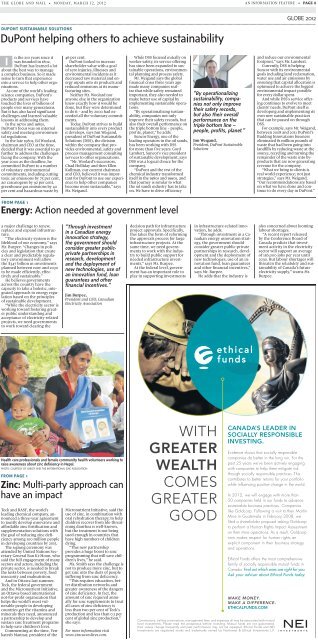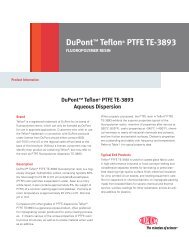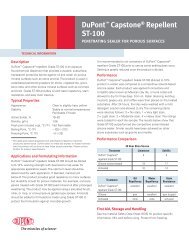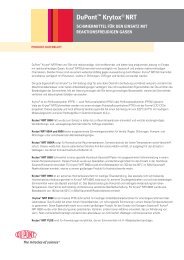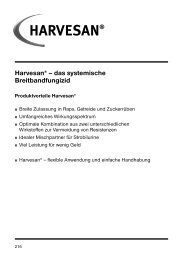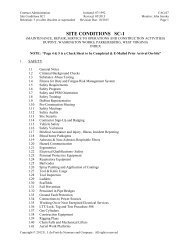"The Globe and Mail" (PDF) - DuPont
"The Globe and Mail" (PDF) - DuPont
"The Globe and Mail" (PDF) - DuPont
You also want an ePaper? Increase the reach of your titles
YUMPU automatically turns print PDFs into web optimized ePapers that Google loves.
the globe <strong>and</strong> mail • mondaY, march 12, 2012AN INFORMATION FEATURE • page 4GLOBE 2012DUPONT SUSTAINABLE SOLUTIONS<strong>DuPont</strong> helping others to achieve sustainabilityn the 210 years since itwas founded in 1802,<strong>DuPont</strong> has learned a lotabout the best way to managea complex business. So it madesense to turn that experienceinto a service to help other organizations.As one of the world’s leadingscience companies, <strong>DuPont</strong>’sproducts <strong>and</strong> services havetouched the lives of billions ofpeople over many generations.But it has also faced significantchallenges <strong>and</strong> learned valuablelessons in addressing them.In the 1970s <strong>and</strong> 1980s,<strong>DuPont</strong>’s focus was on internalsafety <strong>and</strong> meeting environmentalregulations.In the late 1980s, Ed Woolard,chairman <strong>and</strong> CEO at the time,decided that it was essential to gofurther to address the challengesfacing the company. With theyear 2000 as the deadline, hecommitted <strong>DuPont</strong> to a numberof voluntary environmentalcommitments, including cuttingtoxic air emissions by 75 per cent,air carcinogens by 92 per cent,greenhouse gas emissions by 40per cent <strong>and</strong> hazardous waste by46 per cent.<strong>DuPont</strong> looked to increaseshareholder value with a goalof zero injuries, illnesses <strong>and</strong>environmental incidents as itdecreased raw material <strong>and</strong> energyinputs into its products <strong>and</strong>reduced emissions at its manufacturingsites.Neither Mr. Woolard noranyone else in the organizationknew exactly how it would bedone, but they were determinedto do it – <strong>and</strong> by 2000 had exceededall the voluntary commitments.Today, <strong>DuPont</strong> strives to buildsustainability into every productit develops, says Jim Weig<strong>and</strong>,president of <strong>DuPont</strong> SustainableSolutions (DSS), the divisionwithin the company that providesenvironmental, safety <strong>and</strong>process management consultingservices to other organizations.“Mr. Woolard’s successors,Chad Holliday <strong>and</strong> then EllenKullman, our current chairman<strong>and</strong> CEO, believed it was importantfor <strong>DuPont</strong> to use our experienceto help other companiesbecome more sustainable,” saysMr. Weig<strong>and</strong>.While DSS focused initially onworker safety, its service offeringhas since been exp<strong>and</strong>ed to sustainableoperations, environmentalplanning <strong>and</strong> process safety.Mr. Weig<strong>and</strong> says the globalfinancial crisis three years agomade many companies realizethat while safety remainedimportant, they also needed tomake better use of capital byimplementing sustainable operations.“By operationalizing sustainability,companies not onlyimprove their safety records, butalso their overall performance onthe triple bottom line – people,profits, planet,” he adds.Suncor Energy, one of theleading operators in the oil s<strong>and</strong>s,has been working with DSSfor more than five years. GordLambert, Suncor’s vice presidentof sustainable development, saysDSS was a logical choice for thecompany.“<strong>DuPont</strong> <strong>and</strong> the rest of thechemical industry transformeditself in the 1980s <strong>and</strong> 1990s, <strong>and</strong>that journey is similar to whatthe oil s<strong>and</strong>s industry has to takeon. We have to drive efficiency“By operationalizingsustainability, companiesnot only improvetheir safety records,but also their overallperformance on thetriple bottom line –people, profits, planet.”Jim Weig<strong>and</strong>,President, <strong>DuPont</strong> SustainableSolutions<strong>and</strong> reduce our environmentalfootprint,” says Mr. Lambert.Currently, DSS is helpingSuncor with its environmentalgoals including l<strong>and</strong> reclamation,water use <strong>and</strong> air emissions byensuring that capital allocation isoptimized to achieve the biggestenvironmental impact possiblefor every dollar spent.And while DSS’s service offeringcontinues to evolve to meetclients’ needs, <strong>DuPont</strong> itself isdeveloping <strong>and</strong> implementing itsown new sustainable practicesthat can be passed on throughDSS.For example, says Mr. Weig<strong>and</strong>,between 2008 <strong>and</strong> 2011 <strong>DuPont</strong>’sBuilding Innovations businesseliminated 81 million pounds ofwaste that had been going intol<strong>and</strong>fills by reducing waste at thesource, recycling <strong>and</strong> turning theremainder of the waste into byproductsthat are now generatingrevenue for the company.“What we bring to clients isreal world experience; not juststrategies,” says Mr. Weig<strong>and</strong>.“Our recommendations are basedon what we have done <strong>and</strong> continueto do every day in <strong>DuPont</strong>.”FROM PAGE 1Energy: Action needed at government levela major challenge to renew,replace <strong>and</strong> exp<strong>and</strong> infrastructure.“<strong>The</strong> electricity system is thelifeblood of our economy,” saysMr. Burpee. “Changes in policies<strong>and</strong> legislation that createa clear <strong>and</strong> predictable regulatoryenvironment will allowthe $347 billion in investmentsplanned between now <strong>and</strong> 2030to be made efficiently, effectively<strong>and</strong> sustainably.”He believes governmentsacross the country have thecapacity to take a holistic, integratedapproach to energy regulationbased on the principlesof sustainable development.“While the electricity sector isworking toward fostering greaterpublic underst<strong>and</strong>ing <strong>and</strong>acceptance of electricity-relatedprojects, we need governmentsto work toward clearing the“Through investmentin a Canadian energyinnovation strategy,the government shouldconsider greater publicprivatepartnerships inresearch, development<strong>and</strong> the deployment ofnew technologies, use ofan innovation fund, loanguarantees <strong>and</strong> otherfinancial incentives.”Jim Burpee,President <strong>and</strong> CEO, CanadianElectricity Associationdecision path for infrastructureproject approvals. Specifically,this takes the form of reformingthe approvals process for largeinfrastructure projects. At thesame time, we need governmentsto work with the industryto build public support forneeded infrastructure investments,”says Mr. Burpee.At the federal level, governmenthas an important role toplay in supporting investmentsin infrastructure-related innovation,he adds.“Through investment in a Canadianenergy innovation strategy,the government shouldconsider greater public-privatepartnerships in research, development<strong>and</strong> the deployment ofnew technologies, use of an innovationfund, loan guarantees<strong>and</strong> other financial incentives,”says Mr. Burpee.He adds that the industry isalso concerned about loominglabour shortages.“A recent report releasedby the Conference Board ofCanada predicts that investmentactivity in the electricitysector will support an averageof 156,000 jobs per year until2030. But labour shortages willthreaten the reliability <strong>and</strong> sustainabilityof Canada’s futureelectricity supply,” warns Mr.Burpee.Health care professionals <strong>and</strong> female community health volunteers working toraise awareness about zinc deficiency in Nepal.PHOTO: COURTESY OF UNICEF AND THE INTERNATIONAL ZINC ASSOCIATIONFROM PAGE 1Zinc: Multi-party approach canhave an impactTeck <strong>and</strong> BASF, the world’sleading chemical company, announceda three-year agreementto jointly develop innovative <strong>and</strong>affordable zinc fortification <strong>and</strong>supplementation solutions withthe goal of reducing zinc deficiencyamong 100 million peoplein developing countries by 2015.<strong>The</strong> signing ceremony wasattended by United Nations SecretaryGeneral Ban Ki-Moon, whosaid the full engagement of manysectors <strong>and</strong> actors, including theprivate sector, is needed to breakthe links between poverty, foodinsecurity <strong>and</strong> malnutrition.And in Ottawa last summer,Teck, the federal government<strong>and</strong> the Micronutrient Initiative,an Ottawa-based internationalnot-for-profit organization thathelps the world’s most vulnerablepeople in developingcountries get the vitamins <strong>and</strong>minerals they need, announceda partnership to develop <strong>and</strong>sustain zinc treatment programsto help save children’s lives.Commenting at the time, VenkateshMannar, president of theMicronutrient Initiative, said theuse of zinc, in combination withoral rehydration therapy, to helpchildren recover from life-threateningdiarrhea is well-known,but the treatment is not beingused enough in countries thathave high numbers of childrendying.“This new partnershipprovides a huge boost to zincprogramming that will save children’slives,” he said.Ms. Smith says the challenge isnot to produce more zinc, but toget zinc into the diets of peoplesuffering from zinc deficiency.“This requires education, betterdistribution networks <strong>and</strong>greater awareness of the dangersof zinc deficiency. In fact, theamount of zinc required annuallyfor zinc supplements to treatall cases of zinc deficiency isless than two per cent of Teck’sproduction <strong>and</strong> less than 0.1 percent of global zinc production,”she says.For more information visitwww.zincsaveslives.com.WITHGREATERWEALTHCOMESGREATERGOODCANADA’S LEADER INSOCIALLY RESPONSIBLEINVESTING.Evidenceshowsthatsociallyresponsiblecompaniesdobetterinthelongrun.Forthepast 25 years we’ve been actively engagingwithcompaniestohelpthemmitigateriskthroughsociallyresponsiblepractices.Thiscontributestobetterreturnsforyourportfoliowhile influencing positive change in the world.In 2012, we will engage with more than50 companies held in our funds to advancesustainable business practices. Companieslike Goldcorp. Following a visit to their MarlinMine in Guatemala in February 2008, wefiled a shareholder proposal asking Goldcorpto perform a Human Rights Impact Assessmenton their mine operations. As a result, Goldcorpnowmakesrespectforhumanrightsanexplicit component in their business strategy<strong>and</strong> operations.Ethical Funds offers the most comprehensivefamilyofsociallyresponsiblemutualfundsinCanada. Find out which ones are rightforyou.Ask your advisor about Ethical Funds today.MAKE MONEY.MAKE A DIFFERENCE.ETHICALFUNDS.COMCommissions, trailing commissions, management fees, <strong>and</strong> expenses all may be associated with mutualfund investments. Please read the prospectus before investing. Mutual funds are not guaranteed,their values change frequently <strong>and</strong> past performance may not be repeated. Ethical Funds <strong>and</strong> NEIInvestments are registered marks <strong>and</strong> trademarks owned by Northwest & Ethical Investments L.P.


